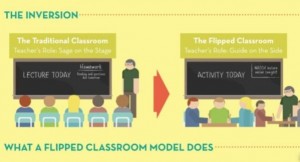 According to the definition of the flipped classroom, the traditional class model is reversed. Short videos and podcasts about classroom content are seen or heard by students at home, and class time is instead spent practicing, exercising and discussing. The flipped content is more than “consume, review, repeat”; it is mostly about including and involving a wider range of learning activities. It is important to remember that pedagogy should be the driving force behind the flipped approach –something that can be a very valuable tool for teachers. Therefore, using podcasts and learning how to create them is a plus for those who want to try to experiment with this pedagogical approach. The positive aspect of the FC is that the teaching space becomes a more active place where to practice certain skills and to foster discussion and critical thinking. Some studies even claim that this approach increases motivation and metacognition. Perhaps the most popular example of videos has been done by the Khan Academy which shows that math learning happens more efficiently if ideas are presented in a number of different ways.
According to the definition of the flipped classroom, the traditional class model is reversed. Short videos and podcasts about classroom content are seen or heard by students at home, and class time is instead spent practicing, exercising and discussing. The flipped content is more than “consume, review, repeat”; it is mostly about including and involving a wider range of learning activities. It is important to remember that pedagogy should be the driving force behind the flipped approach –something that can be a very valuable tool for teachers. Therefore, using podcasts and learning how to create them is a plus for those who want to try to experiment with this pedagogical approach. The positive aspect of the FC is that the teaching space becomes a more active place where to practice certain skills and to foster discussion and critical thinking. Some studies even claim that this approach increases motivation and metacognition. Perhaps the most popular example of videos has been done by the Khan Academy which shows that math learning happens more efficiently if ideas are presented in a number of different ways.
The goal is not too make these podcasts too long (max 10 min) since students have short attention span. Long videocasts create the opposite effect and are not conducive to learning. Some faculty lament that presenting information only via vlogs can have drawbacks. One of them is that the teacher can’t get direct feedback when teaching in the classroom; another is that it can create a digital divide. This year, at BCC, we will test this approach in our summer development workshop, and I will write more about it in the Fall.
Resources:
http://www.qrayon.com/home/airsketch/ (tool for podcasting with Ipad)
http://flipgrid.com/info/ (to create questions by video)
http://www.flippedlearning.org/definition

